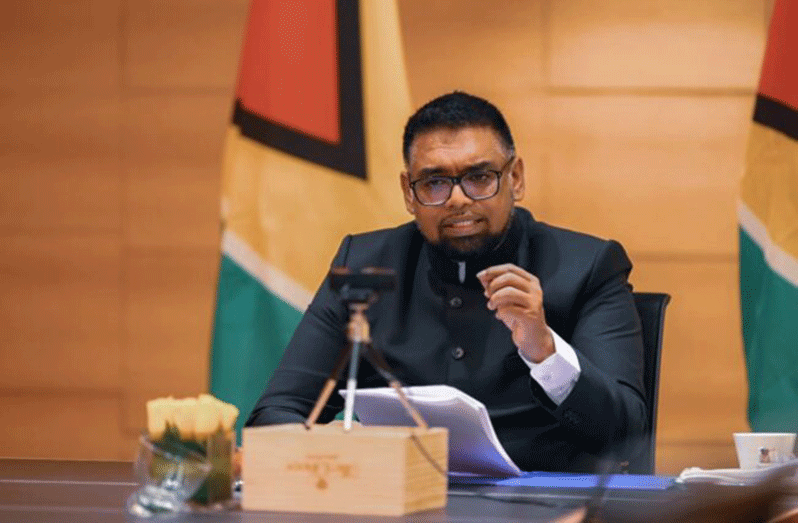President Ali tells agriculture stakeholders; suggests more robust programmes, consortiums
REDUCING the regional expenditure on imported food will require vast investments, but the regional banking sector needs to have more internal drive and commitment to support the ongoing efforts by the Caribbean Community (CARICOM), President Dr. Irfaan Ali has said.
Dr. Ali, during his address at the opening ceremony of the third regional Agri-Investment Forum and Expo held last Friday, candidly said that access to financing is competitive and harsh.
With this in mind, he highlighted that more is required from regional institutions such as the Caribbean Development Bank (CBD) to establish programmes to support the agriculture industry.
“The private sector has to be motivated to invest in agriculture. Unfortunately, our banking sector lacks the internal drive and the internal commitment to food security in the region and I said so, not because we want to pick a fight with the banking sector, but because I believe the banks across the region can do much more and should do much more in supporting food production, agriculture and our farmers,” Dr. Ali told the gathering of both regional and international stakeholders.
Caribbean leaders are currently on a mission to reduce the region’s high dependency on food imports by slashing its US$6 billion expenditure by 25 per cent by the year 2025. The goal is to produce more food and establish policies to ensure that the region is food secure.
In Guyana, the local banks have been supporting agriculture-driven investments to increase food production and adapt newer innovative and climate-smart practices to support the sector.

Dr. Ali, while acknowledging this, said: “When you look at our investment in agriculture, over the last two years, our resource allocation to agriculture and farmers increased by over 300 per cent to more than $33 billion.”
From the local banking sector here, the country has seen a 61 per cent increase in lending to support agriculture projects.
Dr. Ali said: “This tells a story that both in the public and private sector there is great confidence in what we are doing in relation to the 25 by 2025 and in relation to the food production plan.”
The Guyanese Head of State who holds responsibility for food security in CARICOM suggested that consortiums be formed.
“In an environment in which access to financing is not only competitive but also harsh, we have to be very strategic and careful in our planning,” he said.
At a previous forum, Dr. Ali had revealed that for the region to achieve its ambitious food security targets by 2025, it will need to produce in excess of 1.4 million tonnes of commodities over the next two years.
According to President Ali, these commodities include poultry meat, corn, soya beans and rice for feed production; meat (beef, pork and mutton); niche vegetables; and coconut products.
Already, the region has achieved 57 per cent of the production target towards reducing the food-import bill by 25 per cent by 2025; however, stakeholders have to produce 1.4 million tonnes of these commodities.
Notably, Guyana, in the first half of 2023, cultivated over 3,000 acres of soya beans, and over 1,200 acres of corn. The country has also increased its coconut production, with over 5,000 newly-established acres of coconut cultivated from 2021 to January to June 2023 with new coconut nurseries.
Meanwhile, the production of high-value crops such as carrots, broccoli, and cauliflower is being promoted with the establishment of shade houses across the country.
The country has also undertaken several massive projects to increase the production of rice, meat, and dairy products. Investments are also being made to expand the aquaculture sector.
Some US$7.5 billion in investment is needed for the region to achieve its goals.
In February, CARICOM’s Ministerial Taskforce (MTF) on Food Production and Food Security announced that it has collectively achieved 57 per cent of its “Vision 25 by 2025” target.
It was reported that products such as cocoa, dairy, meat, root crops, fruits, and poultry have already reached 96.13 per cent, 84.36 per cent, 72.28 per cent, 70.91 per cent, 70.77 per cent, and 70.19 per cent, respectively, for the targetted production volume set for the year 2025.
Countries such as Guyana, Belize Barbados, Trinidad and Tobago, Dominica, St. Vincent and the Grenadines, Suriname, Dominica, and Jamaica have made significant advances in the production of commodities such as ginger, turmeric, corn, soya bean, root crops, fruits, cocoa, poultry, meat, fish, table eggs, and dairy.



.jpg)








